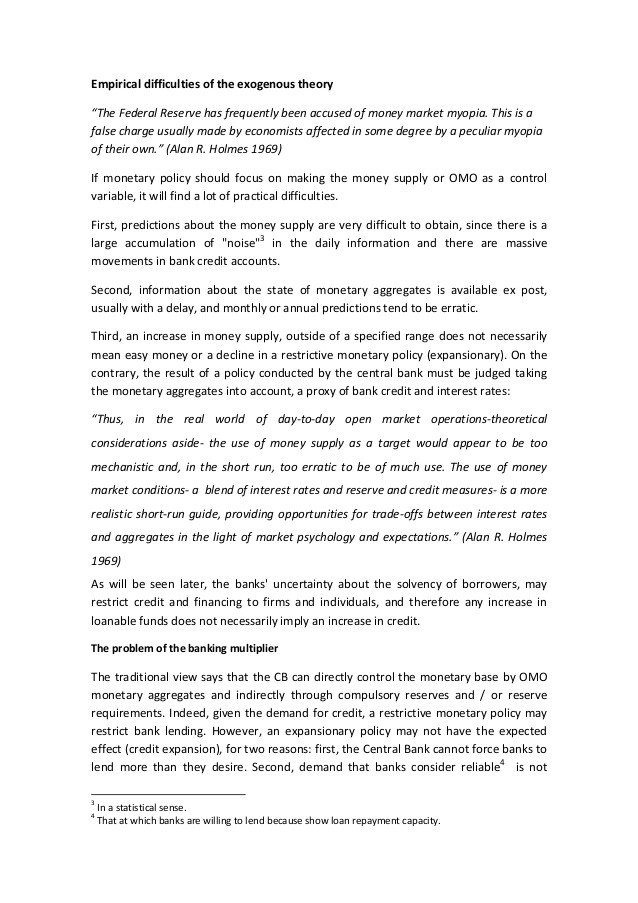The Quantity Theory and Neutrality of Money in an Endogenous Money System
Post on: 16 Март, 2015 No Comment

- Home
- Most Recent Stories
- The Quantity Theory and Neutrality of Money in an Endogenous Money System
Nick Rowe has an interesting post up that I think helps to define many of the differences between the neoclassical view of the world and the heterodox adherents of endogenous money. Specifically, he discusses the ideas of the quantity theory of money and the neutrality of money within a system with endogenous money.
First, theres a lot going on there so lets get specific regarding definitions. So many of the problems in economics rest in the vagueness of the underlying definitions and an inability to construct a coherent and consistent framework. So, lets get on the same page:
Endogenous money means that we all have a version of a printing press. I can create money. You can create money. Corporations issue a form of money (stocks or corporate debt). Governments issue forms of money (currency and government bonds). And banks issue forms of money (deposits primarily). But all of these money items have a certain amount of moneyness based on the scale of moneyness. That is, some items are better suited for actually giving us access to goods and services while others are not.
For instance, you can take out a loan which is like issuing your own money based on your own creditworthiness, but youre really just issuing that money in order to obtain a deposit which is something that everyone else will accept. In a system with financial assets that can be created from thin air the money supply is endogenous. It is not fixed, based on a money multiplier, based on a loanable funds theory or anything like that. We all have a printing press with varying degrees of credibility that gives us access to something with higher moneyness.
The quantity theory of money rests on the idea that there is a quantifiable relationship between the supply of money and the level of prices of goods and services in the economy. This assumes that money is just like any other commodity in the economy and that changes in the money supply will be reflected in the relative value of money to goods and services. The QTM is based on the equation MV=PT (where M is the money supply, V is velocity of money circulation, P is the price level and T is transaction volume).
The neutrality of money assumes that changes in the money supply affect nominal variables and not real variables. That is, an increase in the money supply changes nominal figures in the economy, but doesnt change the inflation adjusted variables. Economists generally assume that the neutrality of money relies on temporal effects as it takes time for the supply of money to impact real variables.
Now, you can see what Ive done here. Ive defined the discussion in MY TERMINOLOGY. That is, Ive taken MY WORLD VIEW of the monetary system and Ive begun to construct these concepts AROUND that view. Obviously, I think that world view is based on a fairly realistic and sound understanding of the system. And once you accept my view of endogenous money the concept of the quantity theory totally changes because the definition of the inputs automatically changes (for instance, M becomes a very murky concept in a world of moneyness). In addition, the idea of neutral money becomes largely useless because my view of endogenous money totally rejects the idea that money is just like any other commodity or that the system somehow looks like a barter system where money is nothing more than another scarce resource (because, obviously, money in an endogenous money world is not scarce at all).
But something much more important is going on in Nicks underlying world view and I think it reflects broader issues in economics. He is taking the neoclassical view where the relevant money supply is determined by the Central Bank. So, if the Central Bank can change the supply of high powered money or fix prices in certain markets then this ripples through the economy as if the Central Bank were the only issuer of money. In essence, it places the money supply directly in control of the Central Bank and assumes that the Central Bank has an Archimedean Lever over the entire economy. The only problem with this view is that there is almost no empirical evidence backing such an idea. In fact, QE and the expansion of the Feds balance sheet in recent years would appear to refute this idea thoroughly (unless, of course, youre willing to buy into lots of other myths like ideas about liquidity traps, expectations or other temporal concepts).
So, what we have here is really a failure to properly connect the dots. In my view, most modern economists dont construct a very realistic framework for understanding the monetary system. And they dont apply definitions to that framework that can be consistent or coherent within a particular framework. And as a result you end up with lots of theoretical views that rely on some twisting of reality to become useful. It doesnt mean that ideas like the QTM or neutrality of money are totally wrong or totally useless. It just means that the framework within which theyre often utilized does not reflect the reality of the system in which we actually reside. And as a result, the end conclusions require a leap of faith and certain degree of political dogma to support.
Got a comment or question? Feel free to contact Cullen via email here or on Twitter here.














